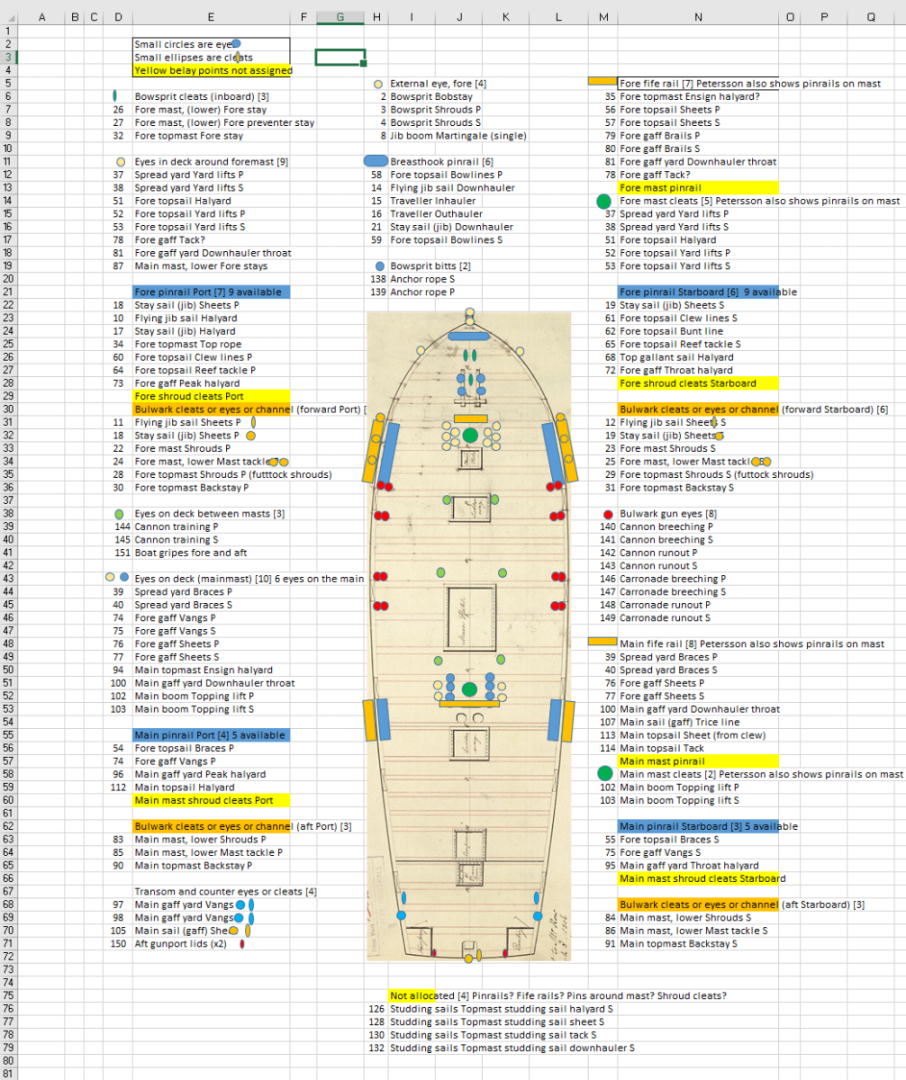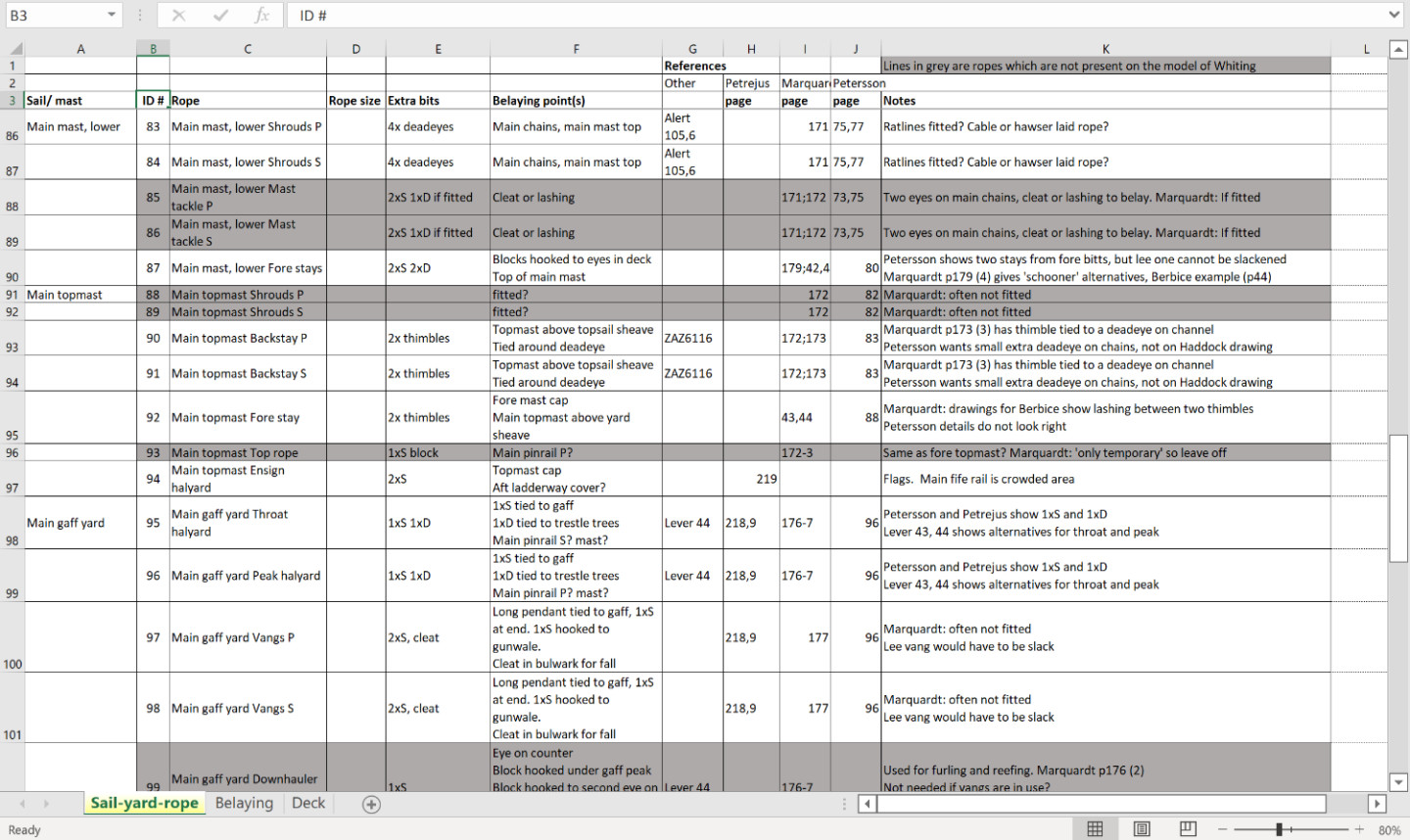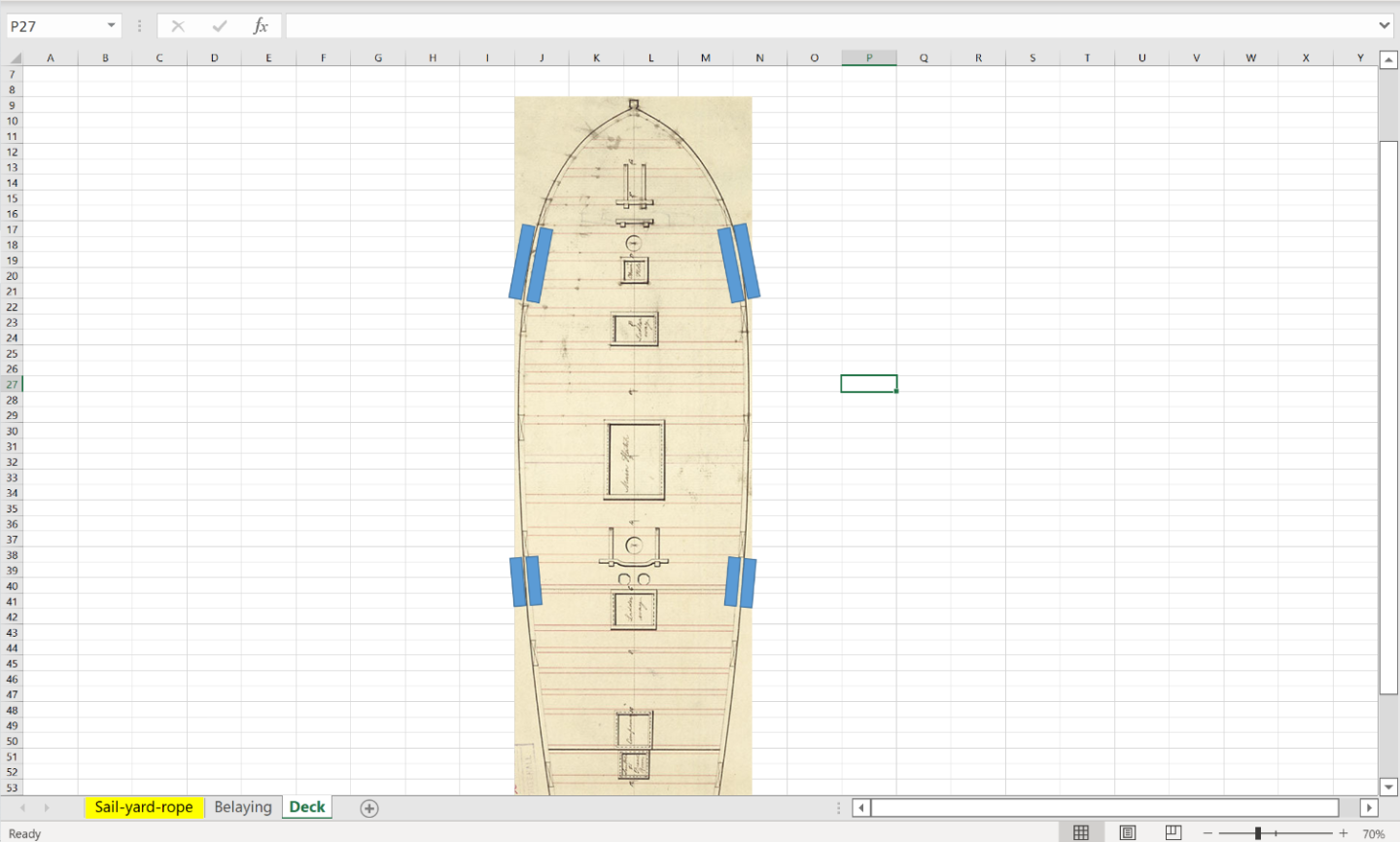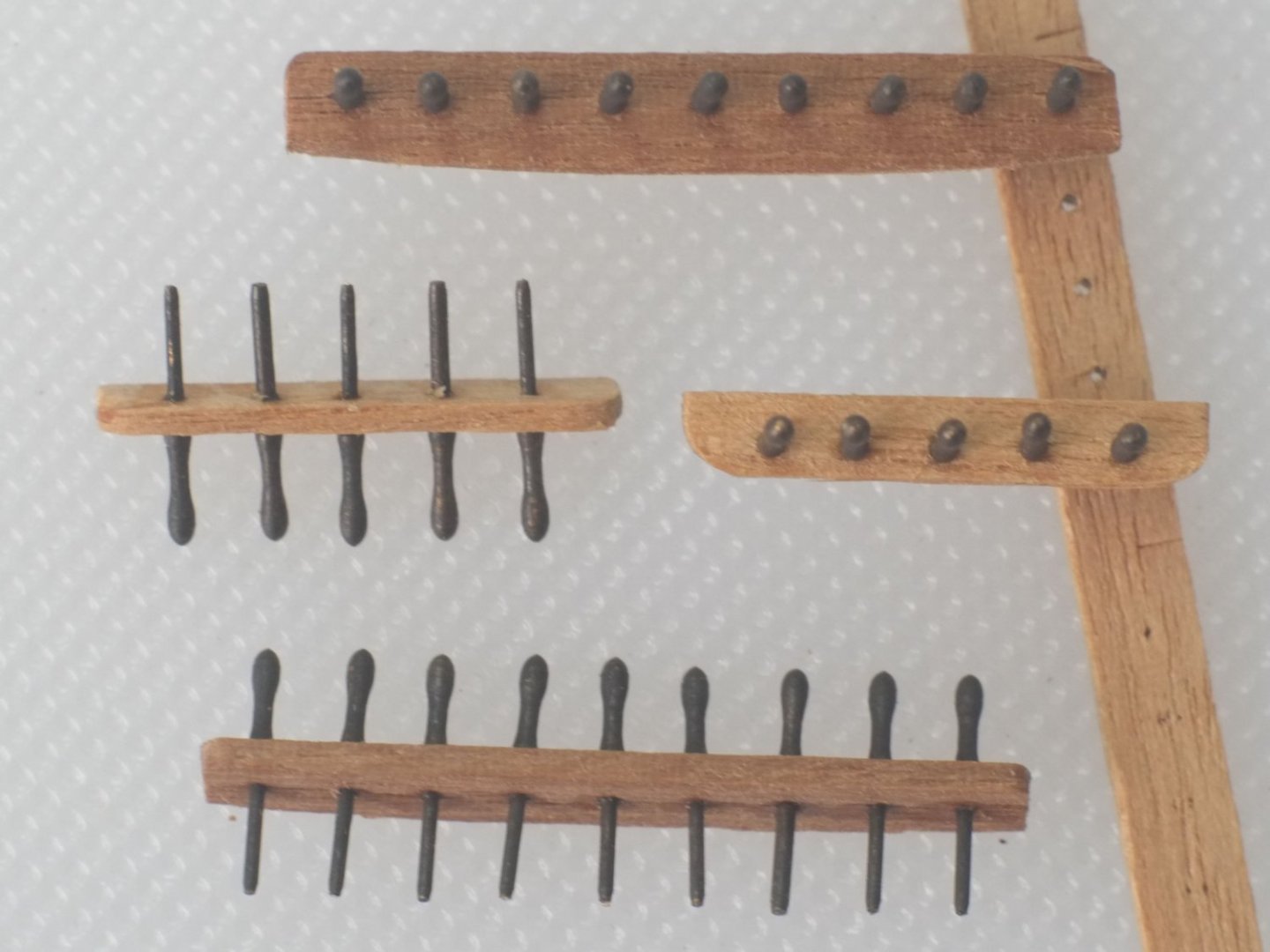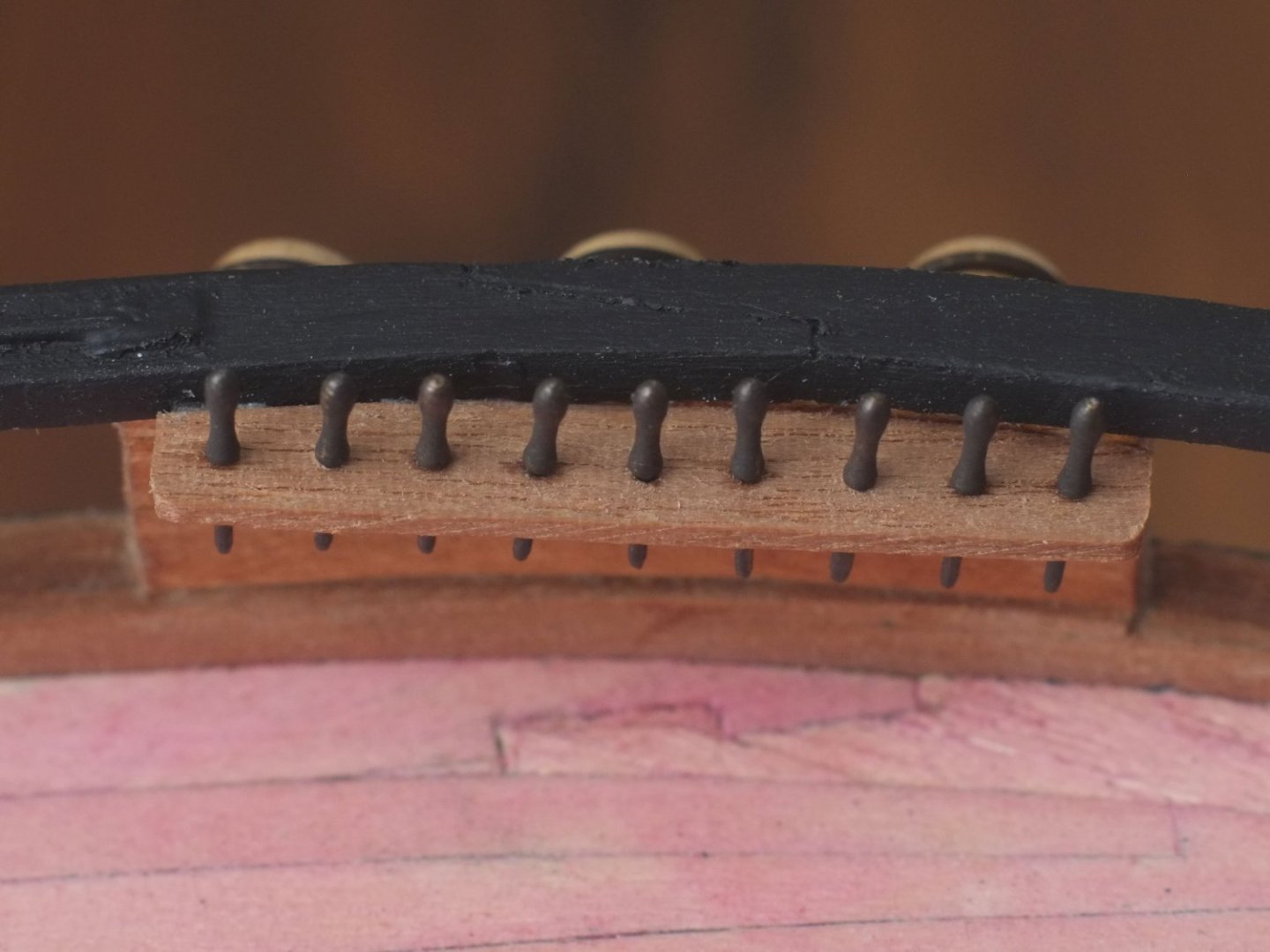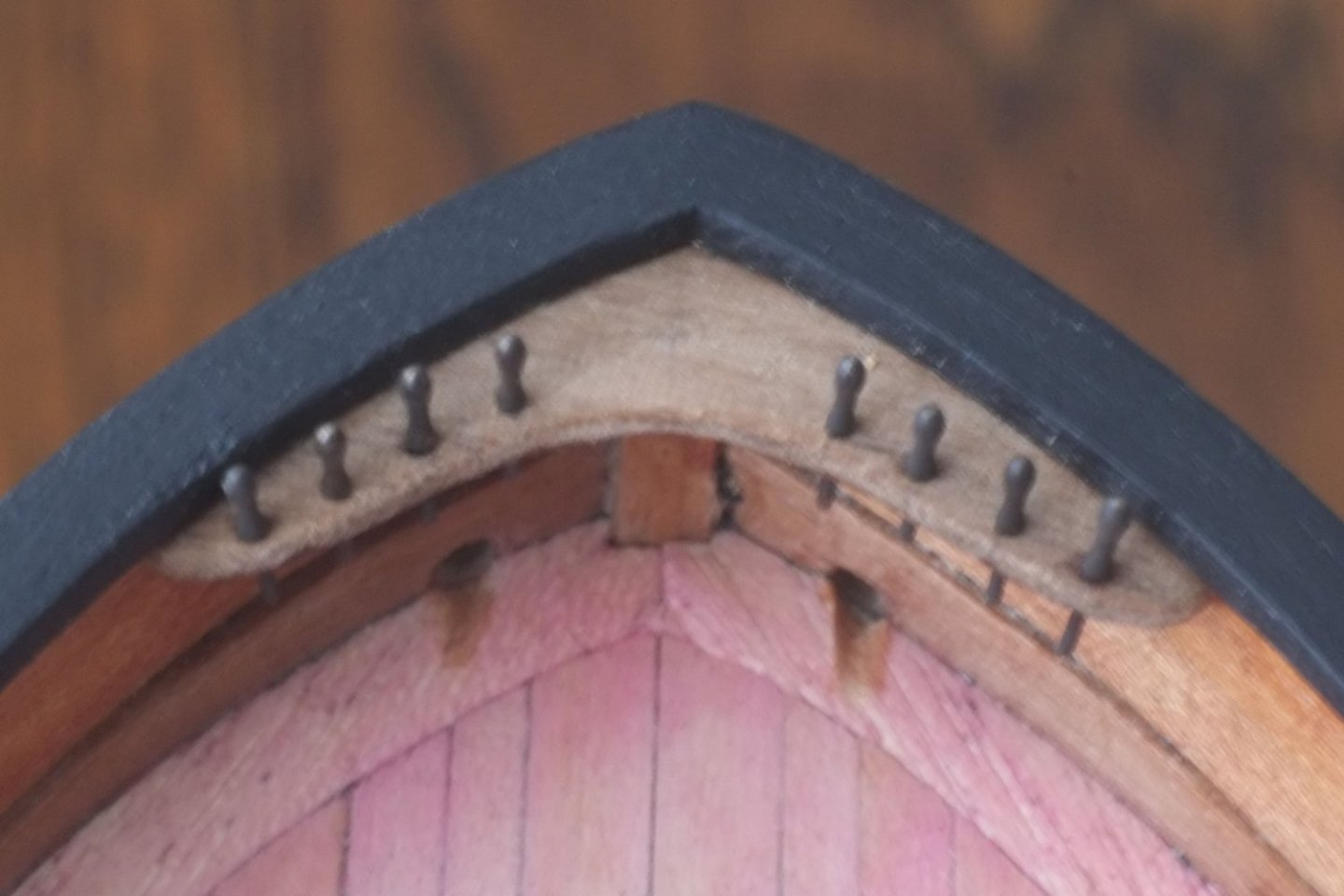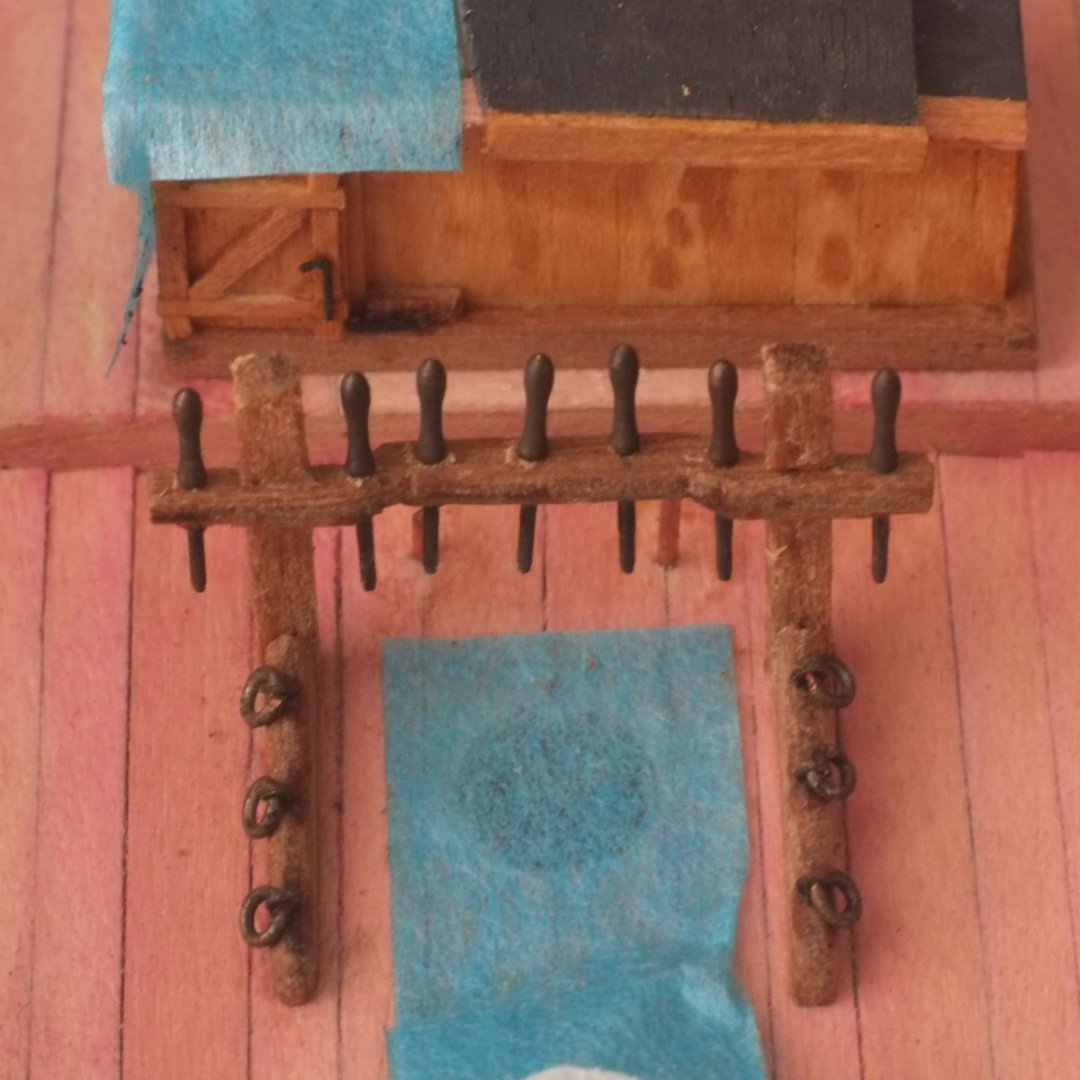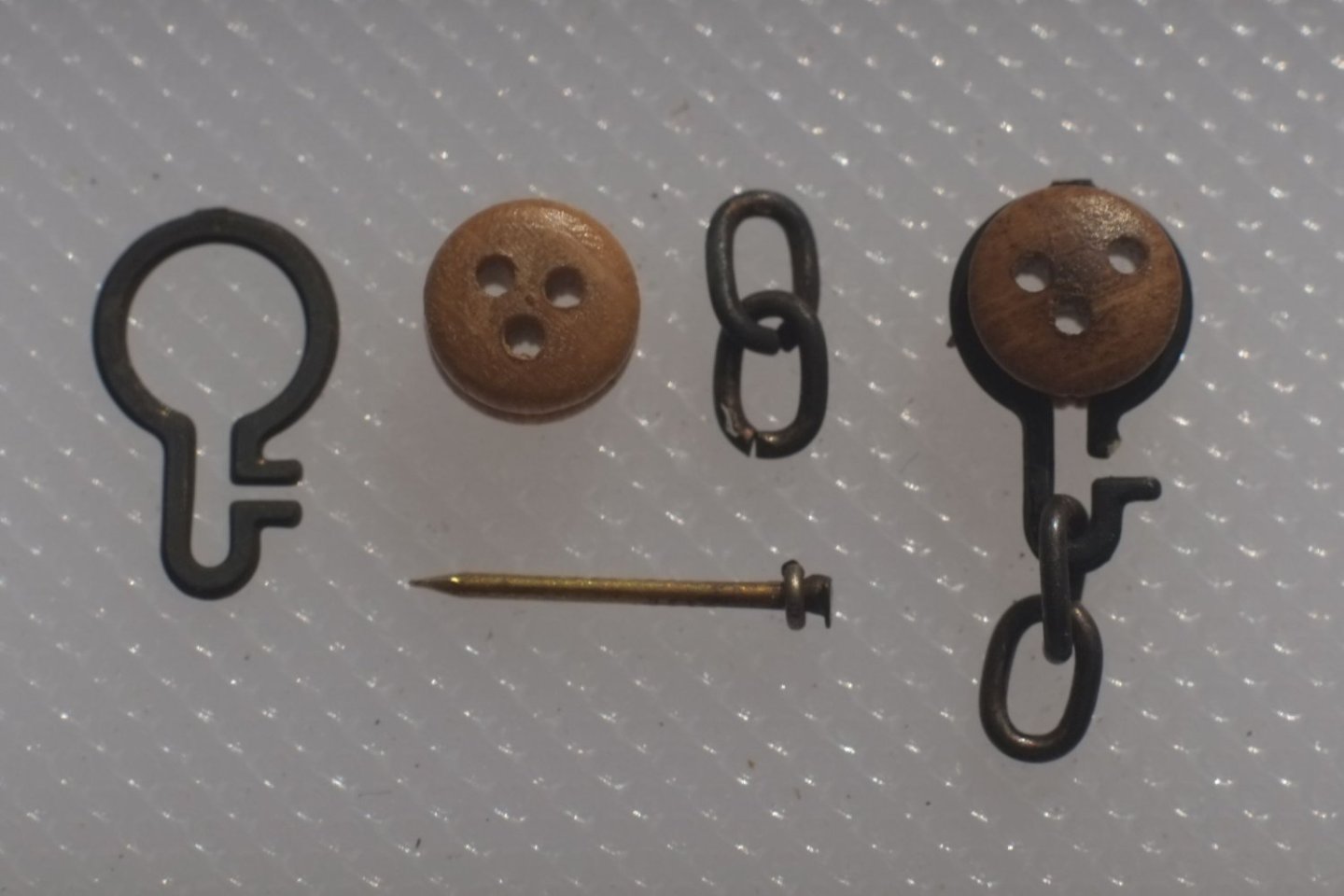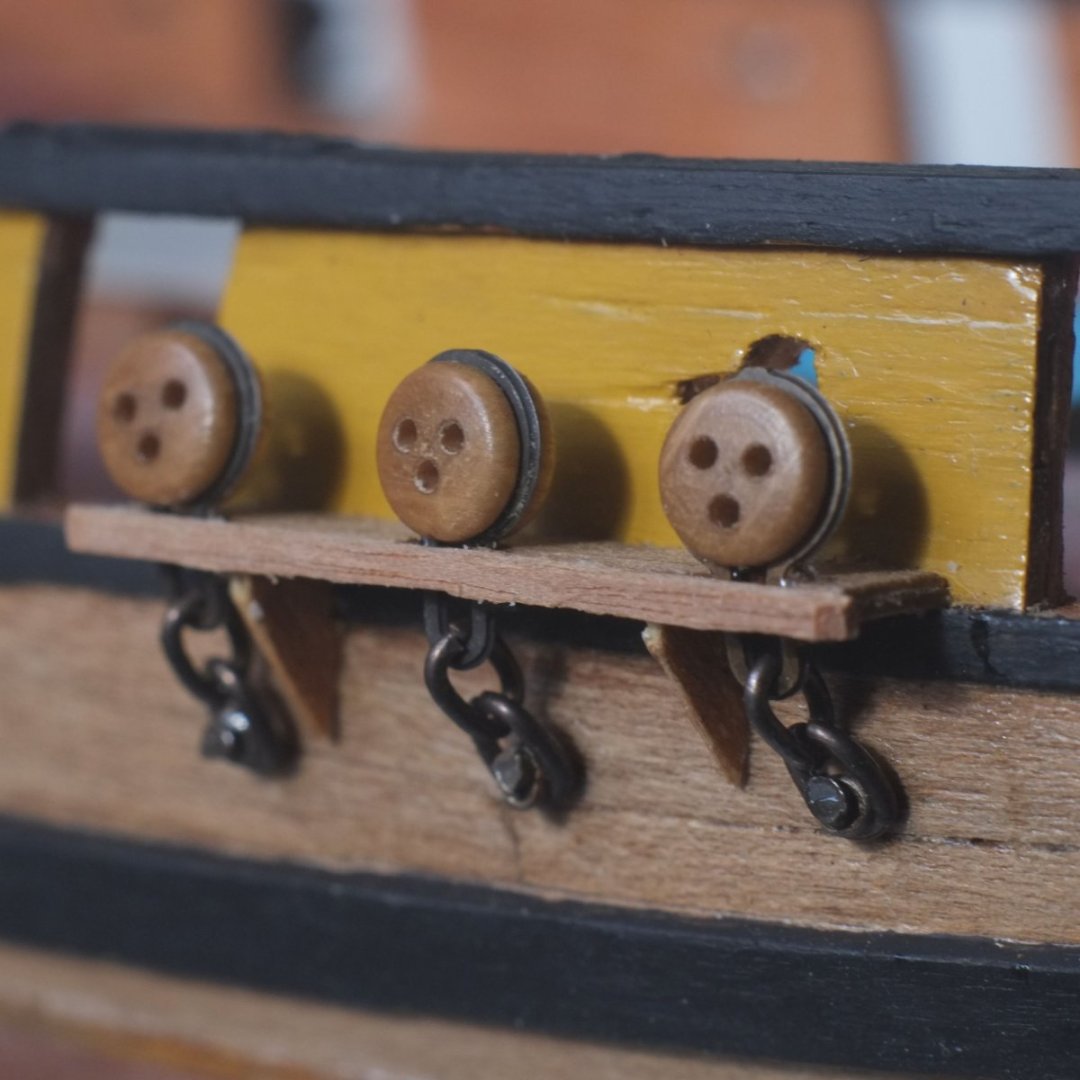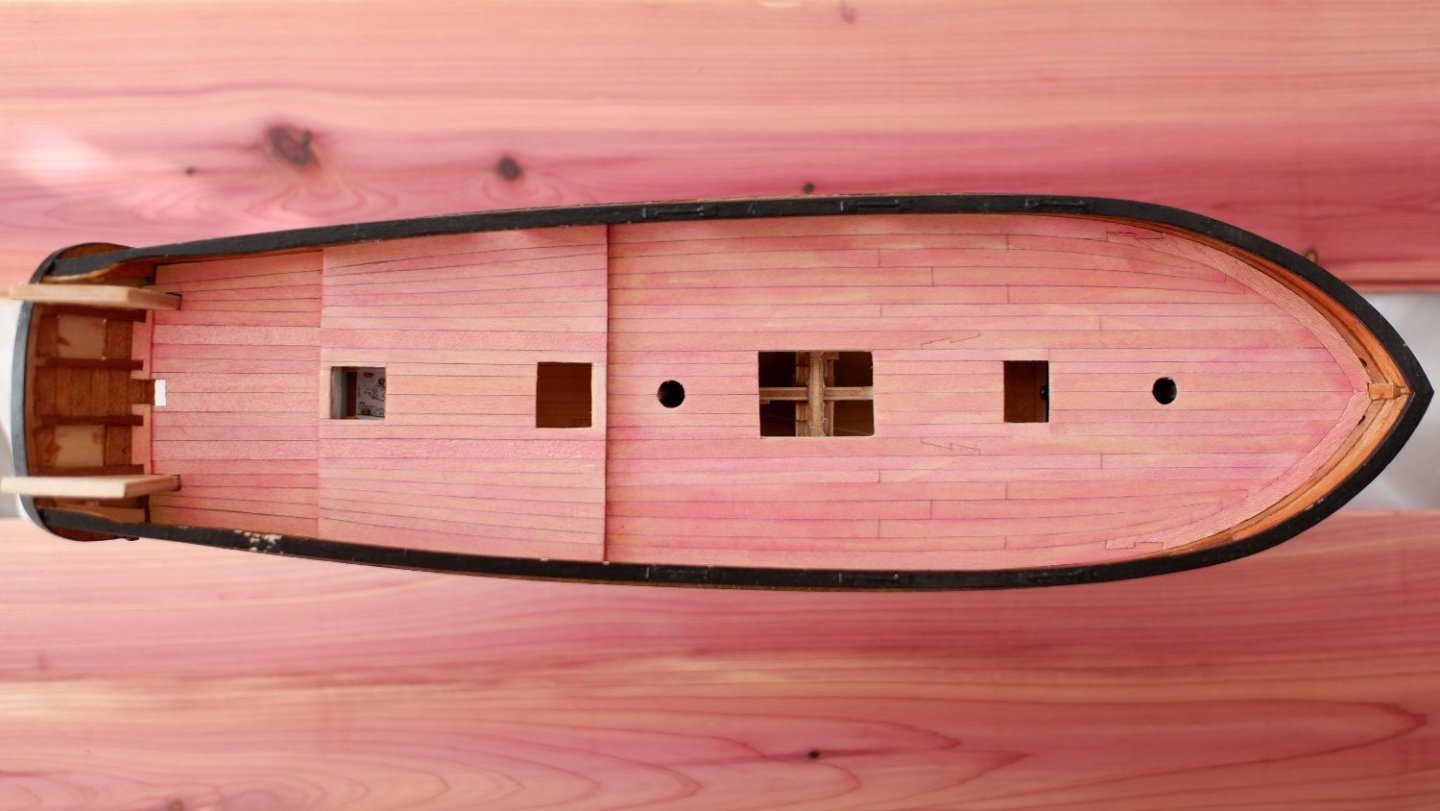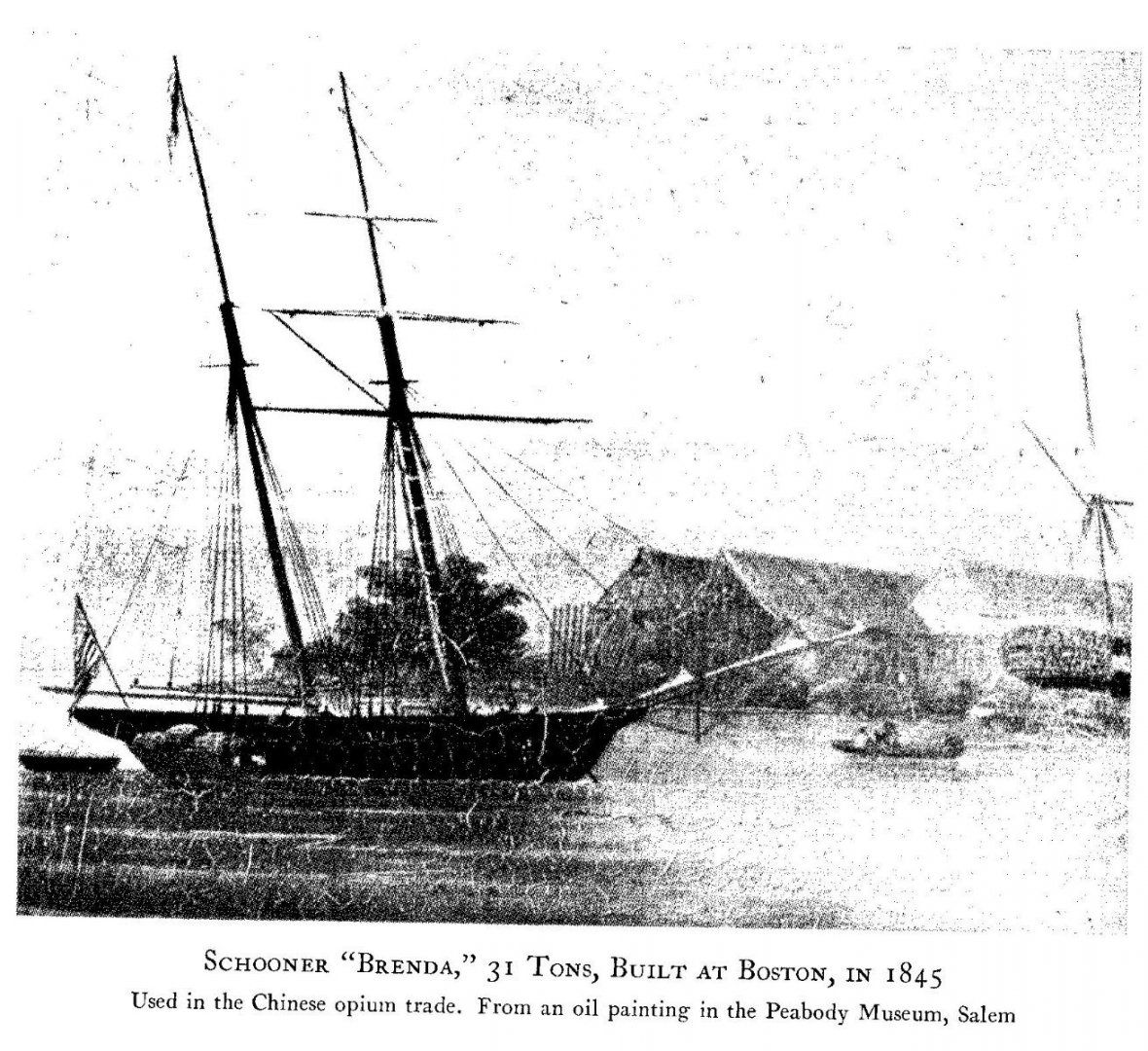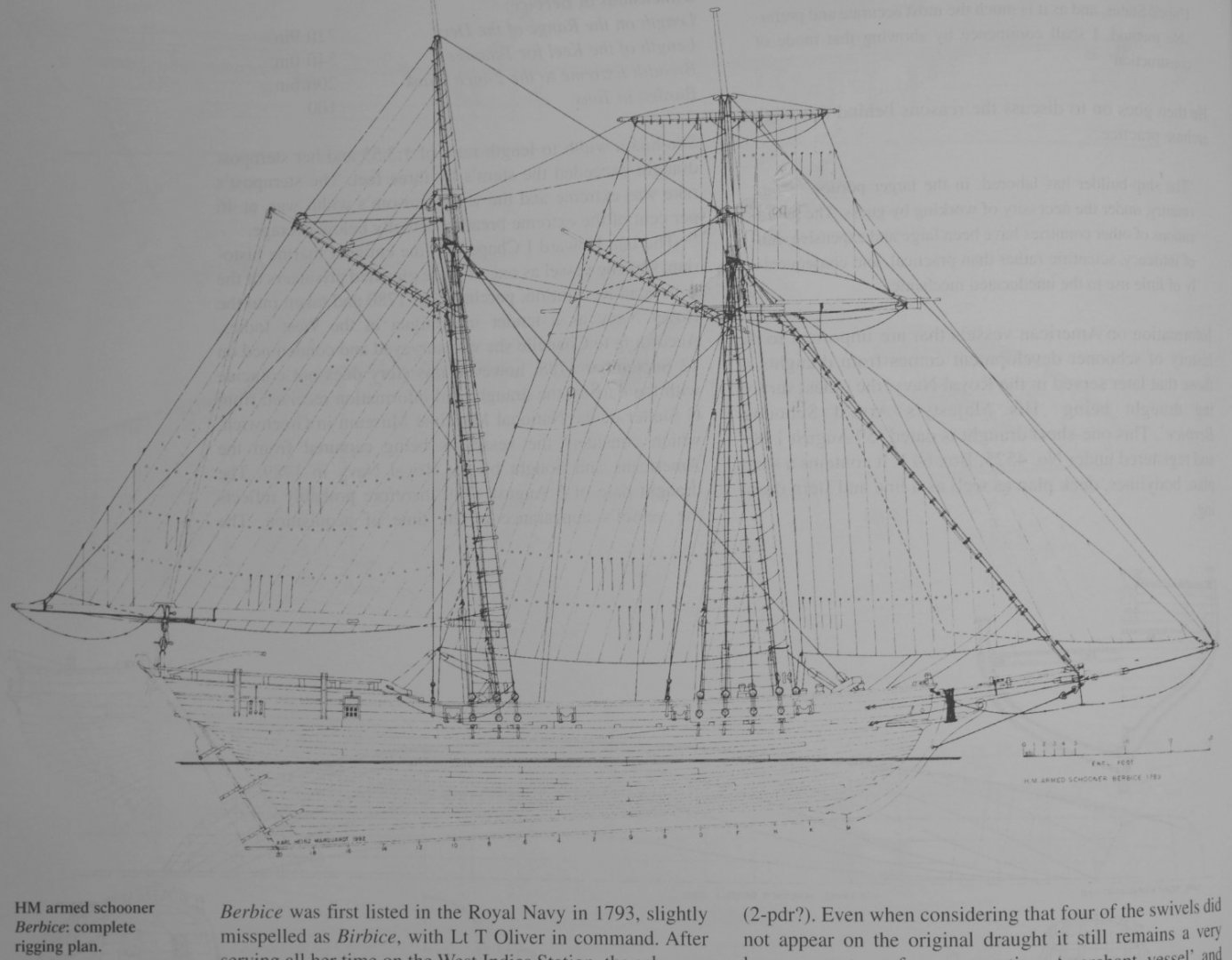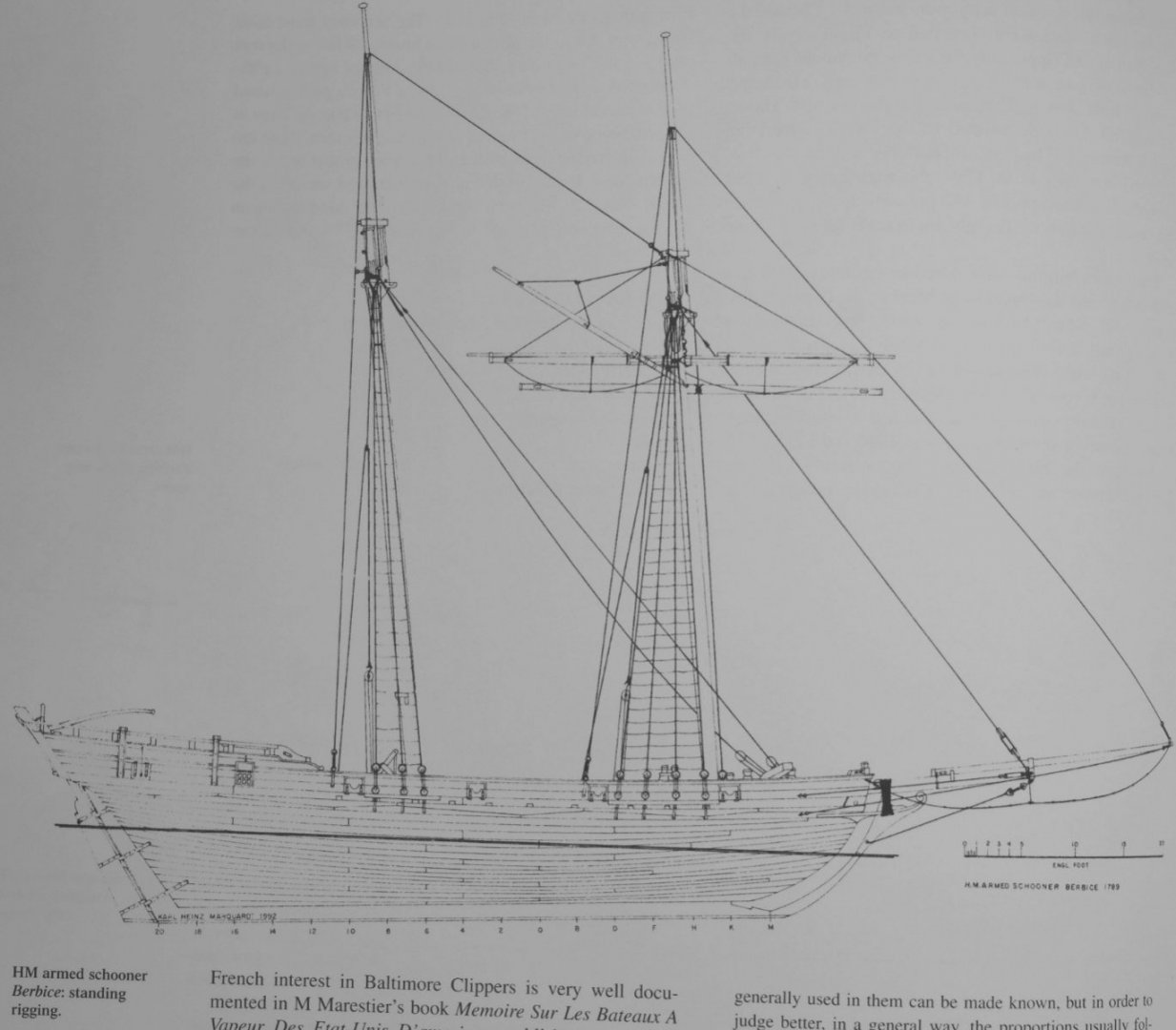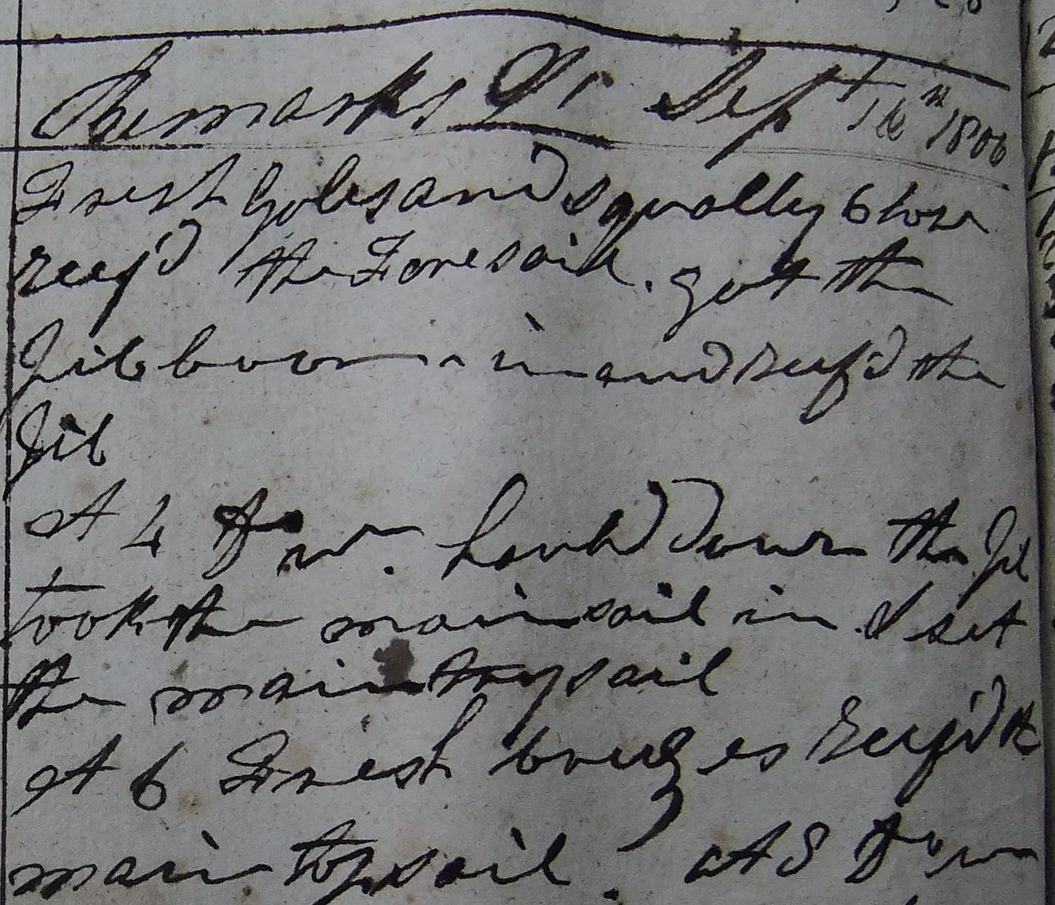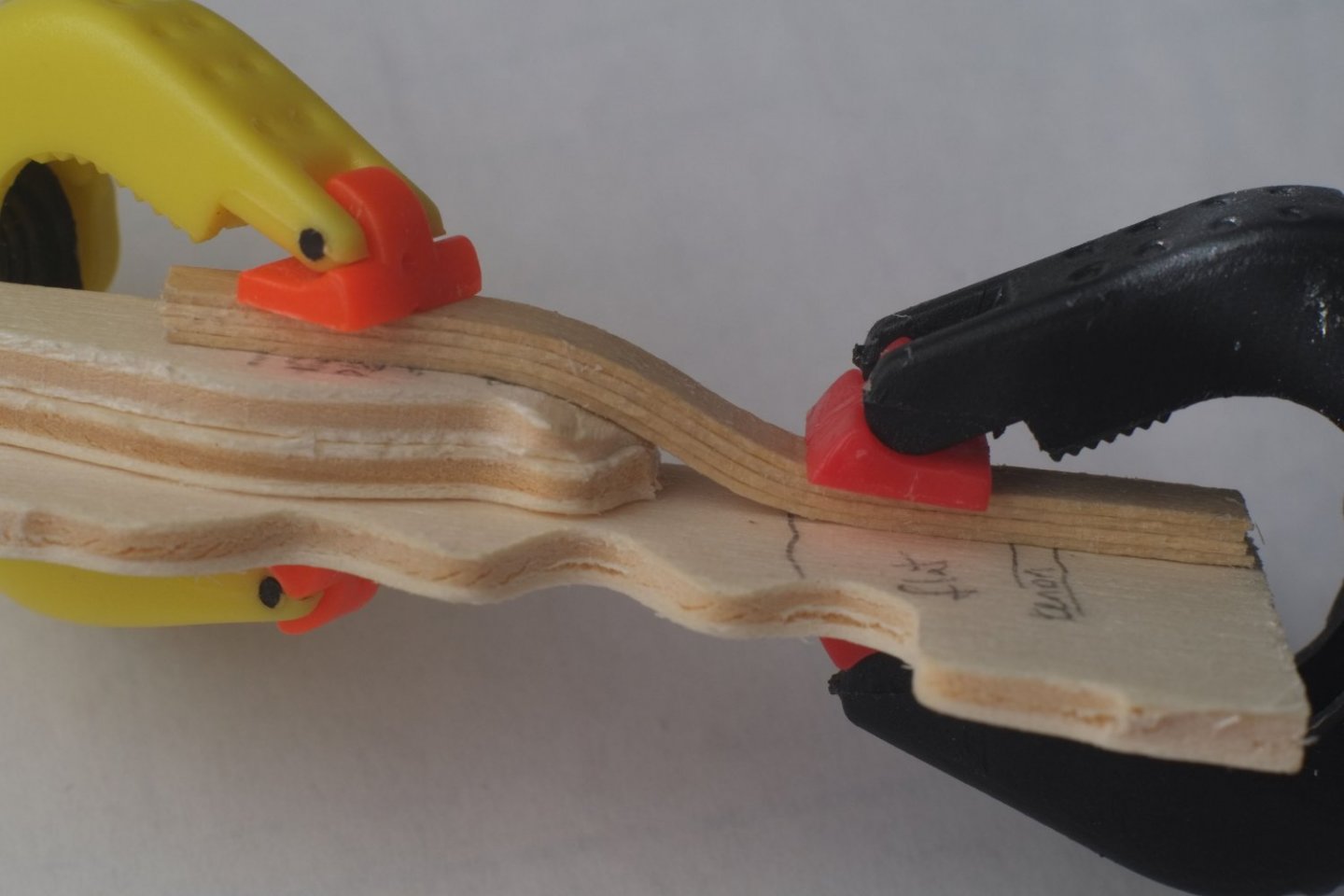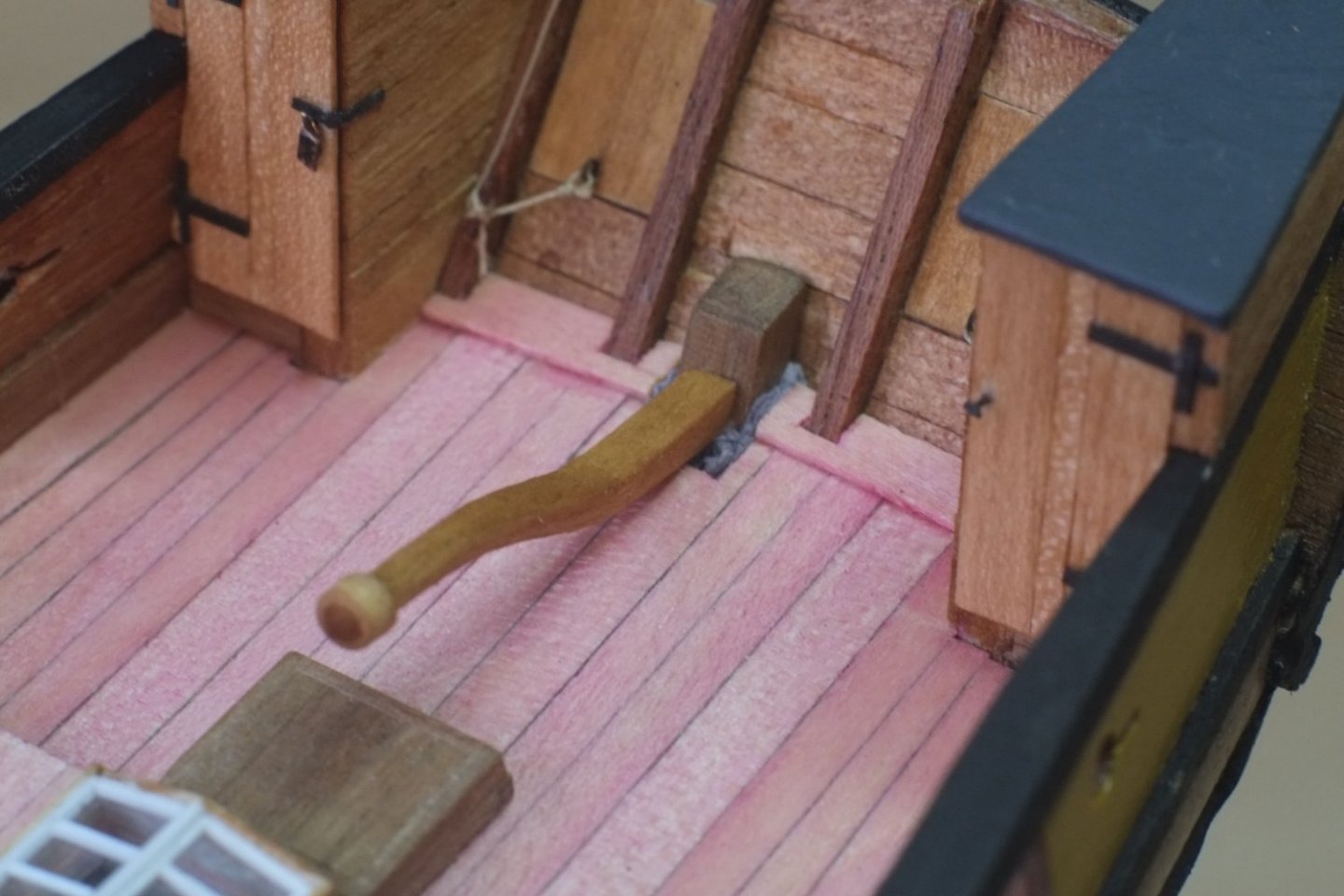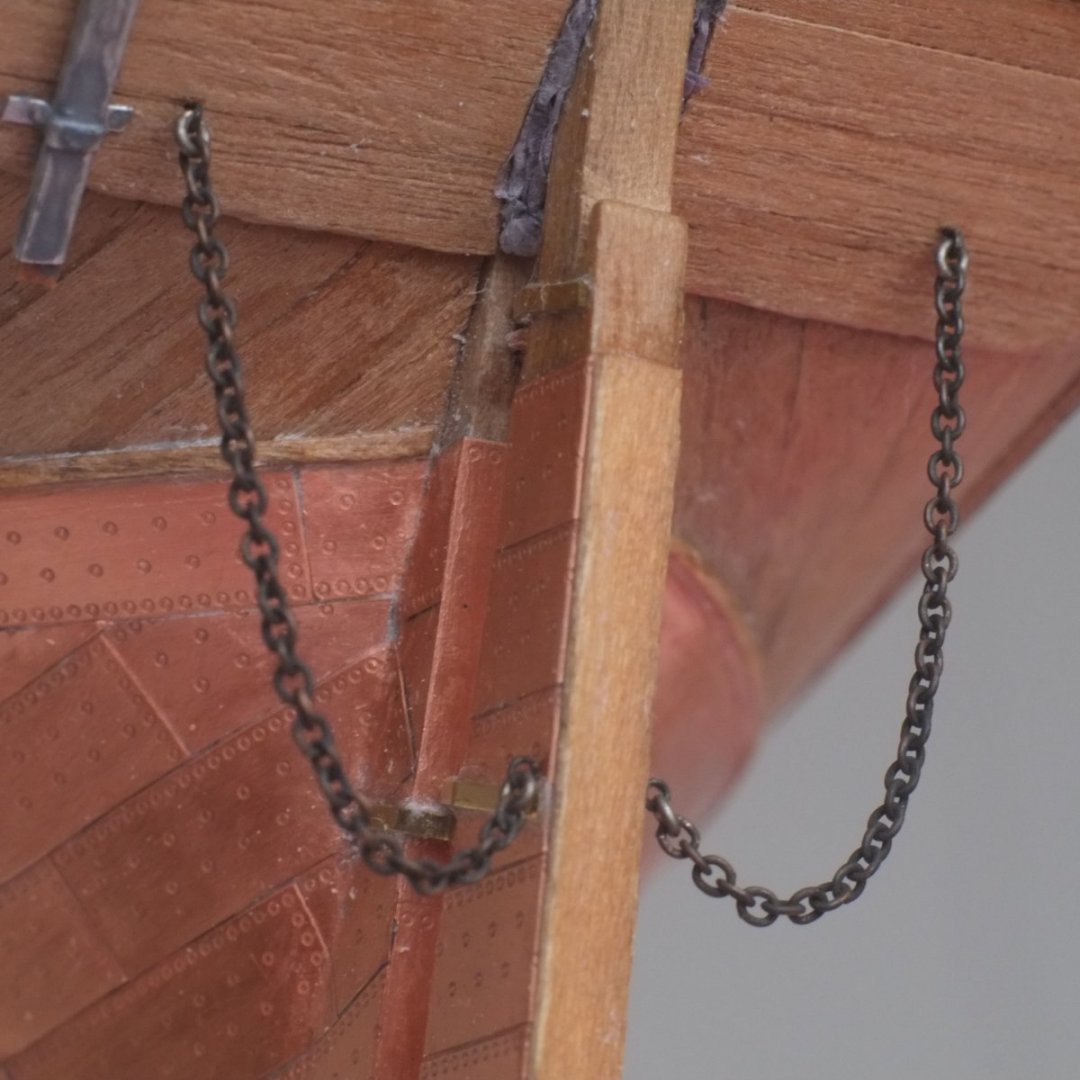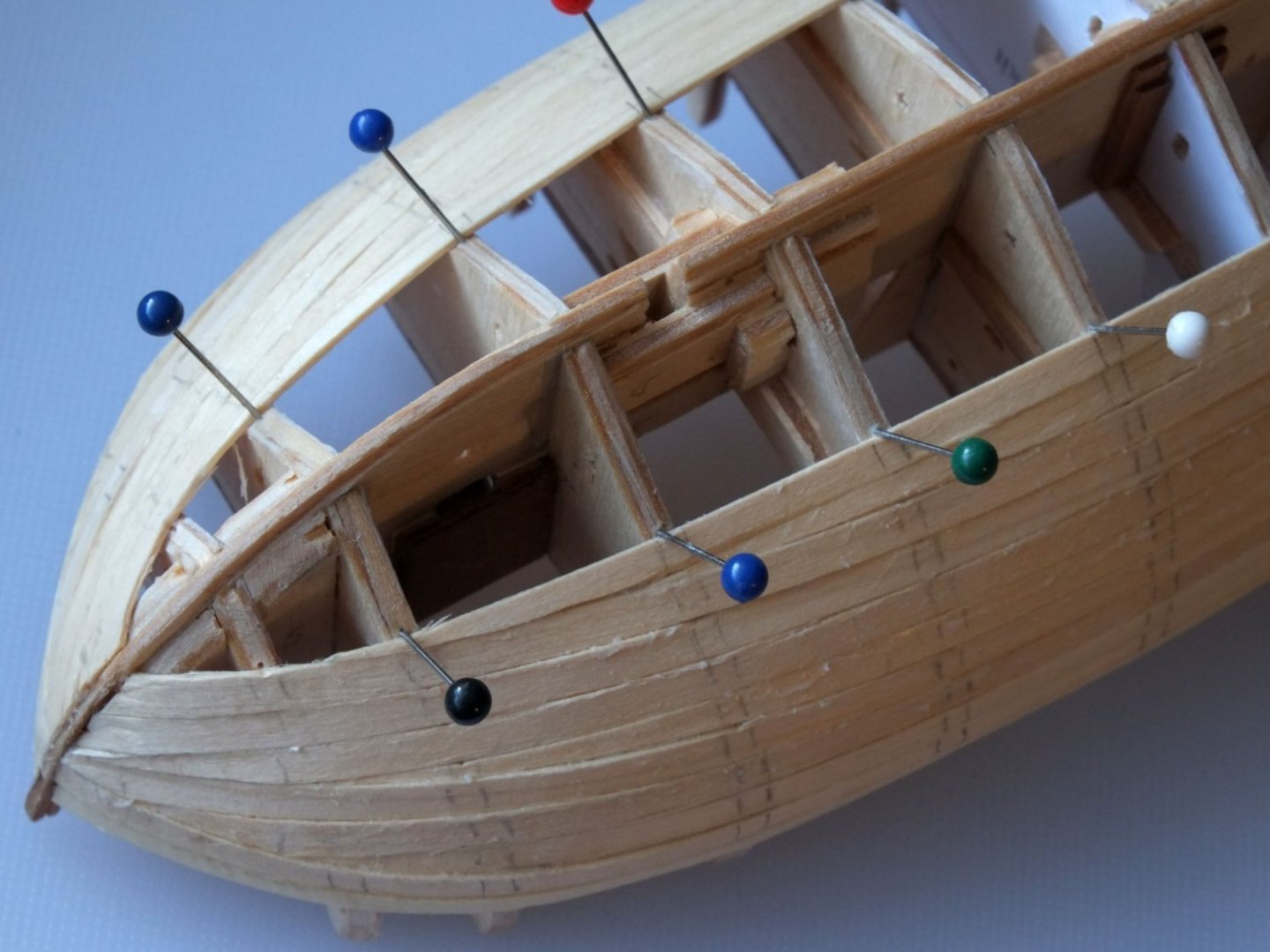-
Posts
298 -
Joined
-
Last visited
Content Type
Profiles
Forums
Gallery
Events
Everything posted by georgeband
-
I have been researching HMS Whiting in obsessive detail for a model of the schooner that I am building. One branch of the research took me off on a tangent which gives a flavour of the war of 1812 from the perspective of a small trading vessel. False colours abound and the boundary between privateering and piracy is definitely crossed. Spoiler alert: at the end the lawyers win. The 1805 Club accepted my paper and published it in their magazine, the Kedge Anchor, earlier this year. I have attached a pdf extract which is only two pages so a quick read. Enjoy! If you don't know about the 1805 Club then have a look on Google. George KA 57 Bandurek.pdf
-

Seats of Ease
georgeband replied to stuglo's topic in Discussion for a Ship's Deck Furniture, Guns, boats and other Fittings
On HMS Victory there were four seats of ease at the heads to serve the needs of about 800 men. (The officers had their own arrangements.) If all the seats are used throughout the day and night that gives just over seven minutes on average for a seaman to finish his business. Given that many of them would be constipated because of the diet, and in rough weather only the two leeward seats would be in use, it is obvious that they would find alternatives such as the bilge or a bucket or leaning out at the channels. Photo below shows the seats on Victory, port side. On smaller vessels the Admiralty drawings often show a cupboard-like structure at the stern to port, tucked in the corner between the transom and the bulwark. It is labelled as the 'necessary' which was a common euphemism at the time. Occasionally the seat was left open to the air and any chance of modesty disappeared. The Simmons thesis, if I remember correctly, also mentions 'pissdales' which are holes through the bulwarks that the sailors could use to relieve themselves without having to open the gun ports. I suspect that there would also be a bucket nearby with strict orders, enforced by the crew, to empty it after you had used it. George -

sail plan for Ballahoo (Fish class) topsail schooner
georgeband replied to georgeband's topic in Masting, rigging and sails
Thank you all for your likes and comments. Phil: I am going through the same thoughts about pinrails and cleats on the masts (Petersson shows two examples) and shroud cleats. I have expanded the second tab to show these additional belaying positions explicitly even though no ropes are assigned to them, yet. Wefalck: Whiting had a crew of 20 so there were enough men and boys to do the work. I have made the fore topgallant flying so there are only a few ropes to raise and handle it. The third tab on the spreadsheet has expanded now. I show which ropes go to which belaying point using coloured symbols on the deck plan. Some on the mast pins or shroud cleats have not been assigned. I have not attempted to put the ropes in order at their belaying point for the moment. There are, for example, seven ropes belaying at the fore, port pinrail in some undefined order. It is enough to let me continue adding the deck furniture. sail rigging plan.xlsx Questions and comments always welcome, that's what lets me improve. George- 22 replies
-
- caldercraft
- jotika
-
(and 4 more)
Tagged with:
-
Thank you for your comment, Tony. I keep wanting to do some 'proper modelling' but find that my research is inadequate and I need to find out more, sift and sort it, shuffle it around and finally turn the data into useful information. I enjoy doing it but it is time consuming. I have added my current work on the belaying plan to another thread so it does not get in the way of the model build log. George
-

sail plan for Ballahoo (Fish class) topsail schooner
georgeband replied to georgeband's topic in Masting, rigging and sails
I have chosen the sail plan for my model of Whiting and it includes a lot of canvas. Working from fore to aft: Flying jibsail Jibsail riding on stay from foremast top to end of bowsprit Gaff fore sail (no boom) Square topsail on topmast Studding sail to starboard of the topsail Flying, square top gallant sail on the same topmast Gaff main sail with gaff and boom Gaff topsail on the main topmast Ringtail sail aft of the gaff mainsail I might well change my mind by the time I get to making these sails... The sizes of the masts and yards must wait a while because the more pressing task is to design the belaying plan for the deck. The belaying plans for schooners depend a lot on where and when and who used it and we do not have 'standard' plans as for ships. Marquardt frequently says that some rope or method might or might not have been used so there is a lot of judgement here. I will describe my method which might help others with this detailed operation. My approach has been to use an Excel spreadsheet to organise the information. So far it has three tabs (sheets) and the first (Sail-yard-rope) is a list of all the ropes that I could think of. I started at the tip of the jibboom and worked aft and up, adding more ropes in a fairly sensible order, until the list stopped growing. That's about 150 ropes for Whiting. The extract below shows the column headings. Sail/ mast. This is the title of a group of ropes. ID #. Reference number that links to the other tabs. Don't put these numbers in until you are confident that you have included all you want. Rope. Name of the rope(s). Mostly single ropes, but not always. For example, I used one line for a group of shrouds that went to the same mast from the same side of the schooner. Rope size. To be filled in later and I will use the traditional circumference in inches. Extra bits. Do I need to buy blocks (1xS = single block; 1xD = double block) or eyes or thimbles... Belaying points. This is summary description of the route that a rope follows. References. I used three main books for reference and they have their own columns where I put page numbers and drawing references. 'Other' has the less frequently used references. Notes. These explain to myself why I made a particular decision, because I will forget later. The lines with a grey background are for ropes which I will not include on my model. Two of them, the main mast tackles, 85 and 86, might yet become part of the plan. The second tab (Belaying) expands the 'belaying points' into one line for each location where the rope makes contact. They are grouped by the locations such as 'Bowsprit cleats' or 'Fore fife rail' which are in column A. I enter the ID # reference number in column B and then a =VLOOKUP formula fills in the other columns for me. One reference number will often appear in several groups if it has a complicated route. The extract below shows that I need three cleats on the bowsprit (I counted them manually, it's not some clever formula) and seven on the fore fife rail. The fife rail is not big enough for this so I have to look at putting pins or cleats on the mast as shown in Petersson's book. The third tab (Deck) is still somewhat embryonic. My intention is to arrange the ropes in their belaying groups so I know which to belay where. Petersson does this well in his book but unfortunately I cannot apply his plan directly to Whiting. I will use the same =VLOOKUP function to add details to this sheet. The reference numbers, ID #, are key. I guess that others have been through the same process and combined snippets of information into a coherent belaying plan. Any comments or suggestions? The spreadsheet is copied below if you want to play with it. sail rigging plan.xlsx George- 22 replies
-
- caldercraft
- jotika
-
(and 4 more)
Tagged with:
-
Pinrails and belaying pins These should have been a quick job, and they were once I had worked out how many pins I needed and where to put them. The time consuming task was to create the belaying plan for about 150 ropes. I will post about this a little later but for now here is what I did with scalpel and glue rather than Excel. I used brass belaying pins made by RB Models and blackened them with Carr's solution. They are much neater than the wooden clubs supplied in the kit. The pinrails are from 4x1mm walnut, cut to the same length as the channels for the deadeyes. The longer, fore rails have a curve on the outboard edge so they sit snuggly against the bulwark below the gunwale. I did consider putting a concave curve on the inboard edge but decided to keep it simple. The aft rails are straight and I reduced the width to about 3mm after drilling the holes for the pins. The holes are 3mm apart. I put the pins into the holes then fixed them from the underside with a tiny drop of CA. The completed assemblies were glued in place with wood glue. Having fixed the pinrails I glued pins into the breasthook and the fife rails. The breasthook has a purposeful look to it now and is calling for ropes to be belayed there. The aft pinrails and fife rail are in a very crowded part of the deck. I snapped out the pumps that I had previously glued in place because there was not enough room for a sailor to squeeze between the pinrail and the pump handle. I am considering shortening the handles (6 foot down to 5 foot) and inclining them forward. George
-
Summer is over and I am back in the modelling season for the next half year. I have been researching during the off-season and collecting and sorting information about masts and sail plans and rigging, of which more later. The practical work restarted last week and I continue with the various fittings on the deck and hull. Deadeyes, channels and chains The deadeyes come from the Ballahoo kit and some are distinctly cross eyed. I also had a few spares in the bits box and selected 20 that are acceptable. The best ones go on the 'presentation' side of the model and the slightly squinting ones on the side that will be facing the wall. The Haddock drawings show that the chains were two links of a chain and not the brass strap in the kit. I used a couple of links from Karaya chain that were the right size. I also used the etched brass frames from the kit to hold the deadeyes, with one sideways protrusion snipped off. The bolt to hold each chain to the hull side is a brass nail with a wire washer. Parts for the deadeyes, and a cross-eyed one assembled for practice The channels are cut from 5x1mm walnut and have triangular knees beneath them. The deadeye and chain assemblies were then glued in place with CA superglue. I used a temporary mast with a thread tied to it to indicate the angles of the shrouds and then marked the position of the bolt so that the chain was aligned with the shroud. A strip of 1x1mm walnut caps the edge of the channel to finish the job. More to come! George
-
Gregg, I actually enjoy tying ratlines and it depends on getting into a rhythm with moving the free end of the thread. It becomes a sort of meditation - Zen and the art of tying knots. Don't forget to seal the knots after you have blackened the threads and before you trim the ends off. There have been many discussions about what to use, or not, on the knots and the consensus seems to be thinned PVA is best, or possibly varnish. CA superglue seems to get a bad press but I have used it successfully. If tying the ratlines is an unwelcome chore you can leave them off the shrouds for the main mast. Several drawings show that there were no ratlines there so you can choose what you prefer. George
- 65 replies
-
- Ballahoo
- Caldercraft
-
(and 1 more)
Tagged with:
-
Bruce, The decking is made from 'Tanganyika' that was supplied with the Caldercraft kit and which I stained pink with a water based dye. I matched the colour to the Eastern Red Cedar which is fresh and still has a lovely smell to it. Could your sample have faded naturally? You have put a worm of doubt in my mind and I hope that I am right about the colour because I do not want to try to change the deck planking. In an effort to get back on topic, I have one of Chris's wonderfully detailed resin boats that will sit on the deck over the main hatch. The hull of the 12 foot cutter does not have thole pins or cut-outs in the top strake for oars. I can work out where the thwarts and oars should go but am unsure whether to cut slots in the top strake or build up another strake above it. Any suggestions? George
-
Did someone mention pink? The various craft built in Bermuda used the local wood, called a cedar or juniper, which happens to be pink. The wood would weather in service and become a conventional grey-brown except for the deck which was holystoned and hence retained its pink colour. The photo below is of Whiting (Fish or Ballahoo class) and I have placed some lengths of Eastern Red Cedar next to her to show what the natural wood looks like. (Bermudan cedar is nearly extinct now and Eastern Red Cedar from the USA is a close relative.) The case will have a pink base to emphasize the colour. I am still undecided about putting her name on the stern. George
-
Phil, Have you considered water based wood dyes? These are available in small (10mL) tester bottles for not a lot of money and in a wide range of colours. I have used them to match lime wood to walnut with a bit of trial and error, and even to create pink deck planking for Whiting. The colours are quite strong and I diluted them before applying with a small brush. Repeat coats allow a lot of control of the depth of colour. 10mL is more than enough for a fleet of model ships. I bought from a company with the intriguing name of Woodeedoo but a quick search on Ebay shows plenty of alternatives. George
-
We do our research and analyse the results and plan our model and perform delicate surgery, and then cut a bit off because it looks better. I wonder how much the old shipwrights followed a drawing or used their own judgement when something did not feel right. Congratulations on your superb workmanship. George
-
Beautiful workmanship here, Phil, and I admire your photography. I am relieved that you managed to find the bits on the floor before the carpet monster devoured them. Marquardt describes a jack staff mounted in a groove on the bowsprit cap to carry a jack (flag) on English vessels. He also shows a 'continental' alternative which does not have the jack staff. I took 'continent' to mean 'European continent' but it could also be American. Petrejus in his superb book shows the same groove and states that Irene, in the Dutch navy, had a small copy of the Dutch flag on the jack staff. I have not checked copies of contemporary paintings of American vessels to see if a they show a flag on a jack staff, and have no idea about regulations at the time. What do you think about American practice? Did they have a flag on a jack staff? George
-
Gregg, Neat work with the decking and the margin planks which will provide a good background for all the other bits on the deck later. One comment about the pumps. These would go above the deepest part of the hold which is between the larger grating and the rear mast. The Admiralty drawings clearly put them there and I think that Caldercraft moved them away from a cramped piece of deck for convenience. If you place them between the two gratings then there will be a lot of water sloshing around in the hold. The kit takes a lot of short cuts with accuracy and the choice is yours: build something which you are pleased with and which looks good to a typical person who admires your work, or historical accuracy to please a pedant. George
- 65 replies
-
- Ballahoo
- Caldercraft
-
(and 1 more)
Tagged with:
-
Gregg, Our modelling skills improve with practice and I look back at some of my old models and wonder why I did what I did. We learn and we get better. Most of your second planking will be covered by paint (unless you choose to go with copper...) and that will hide a multitude of sins which other people will never see. So use the filler and sand it smooth. I find a sanding stick is too small for a hull and use a larger block that fits my hand. Pressing the sandpaper with fingers has its merits too and it allows you to feel bumps and dips. Then put on a decent paint job - lots of coats of thinned paint if you use a hairy stick for painting, or use an airbrush. Choose the colour to suit your needs - bright white is a statement but a yellowy cream is closer to reality if you look at the recipes for 'white stuff'. That leaves the second planking above the waterline. If it is good enough on both sides then be happy. If it is good enough on just one side then that is the side to display and leave the other to face the wall. I would recommend that you continue with your Ballahou. You will learn more when you come to the masts and yards and the rigging and the deck furniture, and will look back later and think that you could have done it better. But your appreciative audience at home will be impressed by what you have created. Then when you come to build your next ship it will be better. George
- 65 replies
-
- Ballahoo
- Caldercraft
-
(and 1 more)
Tagged with:
-
Has anyone tried water-based wood dyes to colour rope? I bought a tiny bottle of 'pink' to mimic Bermudan cedar and it works well on wood. Various shades of browns, greys and blacks would allow the creation of ropes in various stages of tarring from fresh to aged. I suspect that natural fibres will take the dye better than artificial but it needs some experimenting. Unfortunately our house is in chaos at present with major renovations so my experimenting will be delayed for a while. Can anyone relate their experience with wood dyes? George
-
Bit of a gap since I last posted. I have been busy with Whiting but it has mostly been research for the sails and rigging which is in a separate post. https://modelshipworld.com/topic/31489-reef-a-gaff-sail/ I now have a spreadsheet with about 130 lines, one for each rope that I can think of, and notes from Marquardt, Petersson, and others about which way a rope is routed and where it is belayed. The rate of evolution has slowed now so I am probably close to reaching my first proper version. When the spreadsheet is complete I can derive a belaying plan with confidence that there will be enough cleats and belaying pins and eyes. There will also be a shopping list for blocks and other bits. Actual model making has ground to a halt and will remain quiet during the summer season when full size activities on house and garden take priority. George
-
Gaskets and furling The discussions earlier in this thread touched on furling as well as reefing and I would ask for assistance about gaskets. For a square sail the first stage of furling (brailing, clewing) gathers the sail loosely below the yard. It is then pulled up 'accordion style' and the final layer of canvas wraps around the bulk of the sail. Gaskets are looped around the sail and yard to hold everything tightly in place. Drawings rarely show the gaskets but sources such as Falconer describe how they are made and used. For gaff sails the furling is similar. Falconer says that furling can be to a stay or mast and I would expect the guiding principle to be the same as for square sails - create a tight bundle that the wind cannot tear open. Lots of paintings and photos show a brailed gaff which is the first, loose gathering of the sail. Sources such as Lever agree that there were typically two or three brails for a sail and this is supported in the pictures. The final, tight furl is less commonly seen and the example below is from Chapelle's Baltimore Clipper (opposite page 142). The main (aft) gaff sail is sandwiched between the boom and the gaff which has been lowered to meet it. There look to be some features on the furled sail but I cannot discern what they are. (That shore line complicates the interpretation.) The fore gaff sail does not have a boom and has been furled to the gaff yard and the mast. We can see the hoops around the mast but again the details of the final furling are poorly resolved. There may be something wound around the mast and sail to hold it together but I am not sure from this picture. My assumption for modelling is that there would be gaskets to tie the sail to its yard or mast. If the sail is open then I presume the gaskets would either hang loose or hang in a coil. The questions then are how many gaskets and where do they attach to the sails? Sail with gaff and boom. The gaskets are probably tied to the top of the sail by the gaff and are accessible from deck when furling. I guess that there might be two or three of them. Sail with no boom. Two or three gaskets would hold the sail to the mast. I have not seen horses below the gaff yard so I expect that there are no gaskets along the gaff and we rely on the brails to pull the top part of the sail taut. Does anyone have information to add to this? George
-
Thanks everyone for your practical insights which show how this issue can be solved on some craft in some periods. However, the Berbice problem still haunts me and I cannot see how that fore gaff sail would be reefed without step ladders or extreme acrobatics to reach the reef points. This is when I change from scientist to engineer and devise a practical solution for Whiting for which we do not have good information and can make our own choices. The fore gaff sail on my Whiting will Have a gaff yard that can be lowered Lacing on the mast which can be unrove (if that is the right term) from the lower end if the sail is reefed and lowered Some way to hook a tack to the fore edge of the sail when it is reefed. The illustrations of gaff sails that I have seen have a reef cringle at the ends of each reef band and this might be the way to do it Some way to hook the sheet to the aft edge of the sail when it is reefed, probably though a reef cringle again Brails for brailing Some ropes to tie the furled sail to the mast, equivalent to the gaskets on a square sail. These could also attach to the reef cringles on either the fore or aft edge or both. Can you point out the flaws in this plan and put forward improvements? George
-
Phil, I am sorry that I have to disagree with some of your statements here. My knowledge comes from what I have read in Marquardt, Chapelle, Lever, Petrejus and others and fundamentally I agree that schooner rigs were not consistent, though some arrangements were more common than others. A little on terminology. Furling or handing refers to securing a sail in a safe, unused state on the yard or mast. Brailing, according to Falconer, is a preliminary stage of furling when a sail is gathered up. Reefing is reducing the area of a sail in strong winds. For square sails the reef points are usually near the top and are tied over the yard. For gaff sails the reef points are usually near the bottom and the sail is gathered by them. Gaff sails are laced or otherwise tied to the gaff yard at the top. The leading edge is secured to the mast by hoops or more lacing. The clew at the lower, aft end is fixed to the boom if there is one. If there is no boom then the sheet is secured to a cleat via some arrangement of blocks. The lower edge of the gaff sail, as far as I know, was not laced to the boom but it might be different in current practice. Phil's photo of Pride of Baltimore II shows the main (aft) gaff sail straining at the clew where it is attached to the boom. The sails on the fore mast have been brailed, though technically the topsail might be 'clewed up'. To reef a gaff that also has a boom the sail was lowered until the reef points could be reached and tied together. To furl the sail it was lowered further until the gaff reached the boom and there are paintings that show this. Marquardt and others describe this well. Brailing was 'sometimes' used for a gaff when there is a boom, but apparently was not normal practice. To reef a gaff that does not have a boom, the sail was similarly lowered and the reef points tied together. Furling was a different action and Phil's photos show it well. My original questions still stand. If the gaff is laced to the mast does this prevent it from being lowered? If the gaff is fixed and cannot be lowered, how do the sailors reach the reefs? The answer might be that current drawings are mistaken, but I suspect it is that my knowledge of reefing is simply inadequate. The two pictures below are of Berbice from Marquardt's Global Schooner. They show Reef bands on the sails Lacing around fore mast and hoops around main mast Standing rigging to hold the fore gaff - it did not have blocks to adjust the height Main gaff sail is not laced to the boom. George
-
A lot of the drawings for schooners and other vessels show a gaff sail with a boom below it. The sail is laced to the gaff and joined to the mast by hoops. To reef the sail I assume that the gaff is lowered and the reef pendants are pulled until a reef band reaches the boom, at which time the sailors reach up and tie the reef points together to shorten the sail. So far so easy, in principle, though I don't doubt the sailors' strength and courage when it was wet and windy and dark. The fore gaff sail on a schooner does not usually have a boom and appears to be laced to the gaff yard and to the fore mast. The gaff itself is often fixed and cannot be lowered or dipped. There are lots of example drawings in Marquardt's Global Schooner and one I have in front of me is HMS Berbice (pp 42-45). The sail has two reef bands so it can be reefed, but I cannot see how this would be done. The sail cannot be lowered because of the rigging of the gaff yard and the lacing on the mast. To raise the lower edge by reefing, the lower part of the sail would have to lifted and again the lacing makes this difficult. There is the added complication that the sailors would need step ladders to reach up to the reef bands. In Chapelle's Baltimore Clipper the line drawings do not show hoops or lacing. However, the copies of contemporary paintings often show the fore gaff to have hoops joining it to the mast in the same way as the main gaff. I cannot see whether the gaffs are fixed or moving; it is probably more likely that they can be lowered otherwise why have mast hoops? I suspect that Marquardt's drawings have adopted a convention, though they could describe a reality. It all depends on how the fore gaff sails were reefed. Does anyone know? George
-

sail plan for Ballahoo (Fish class) topsail schooner
georgeband replied to georgeband's topic in Masting, rigging and sails
After a pleasant diversion when I have actually been making the deck furniture on Whiting I return to the sail plan. The reason is that I have to understand the rigging plans so that I can put eyes and pinrails and cleats in the right places. I have read through my transcriptions from John Roach's log again, and expanded them, and old doubts and uncertainties have resurfaced. Log book Remarks for September 16th 1806 Fresh gales and squally close reef'd the foresail, got the jib boom in and reef'd the Jib At 4 Do.W. [same weather] sent? down the jib took the mainsail in & set the main try sail at 6 Fresh breezes reef'd the main topsail… The log book often refers to a 'fore sail'. My assumption was that this is the large gaff sail on the fore mast and not the course or lower square sail. I now realise that this was an assumption and that 'fore sail' could be the course, or the gaff, or either depending on what Sub-Lieut Roach thought at the time. The fore sail could be double reefed and this is consistent with a course. It is also consistent with a gaff sail if it has hoops around the mast so it can be lowered, and according to Marquardt this was less common for the fore gaff which did not have a boom. In an earlier post I mentioned the lower studding sail which could be a water sail, or it could sit next to the course. So was the 'fore sail' a gaff, a course, or either? Reefing the jib is quite understandable if it rides on a stay and many illustrations show reef points on a jib or stay sail. The entry for 19 September says put the Bonnet on the Jib which I was not expecting because it seems to ask a lot of the jib sail to reef it and extend it. But who am I to judge with zero experience of sailing a schooner? I am puzzled by reefed the main topsail. There are other references to a gaff top sail which I take to be on the main mast and I have not seen illustrations of one with reef points on it. Even if it did have reef points it would be suicidal for a crew to try to reef it unless the sail and yard were properly set up for this activity. Was there another, square topsail on the main mast? Or did Roach make a mistake in his hurry to complete the log? Or have I misread it? Help! George- 22 replies
-
- caldercraft
- jotika
-
(and 4 more)
Tagged with:
-
I would keep going in sequence and put the garboard strake in last. It is tricky to fit the last plank wherever it sits but the garboard is, in my opinion, the less difficult to trim to shape. Be prepared for stealers now. At the bow you will find that the tapers go to a point and fall short of the stem post unless you do something smart. Similarly at the stern you will find gaps between the planks that need to be filled. Simple triangles will do at the stern or you can try to follow real practice. (If you are painting the hull below the waterline no one will know if you take some shortcuts.) George
- 65 replies
-
- Ballahoo
- Caldercraft
-
(and 1 more)
Tagged with:
-
Thank you, Tony, for your kind words and reminding us where to find the discussion about binnacles. Thanks to all for 'likes' which are a real morale booster. Rudder I described construction of the rudder in earlier posts when I was coppering the hull and it has now been finished and mounted. Tiller The tiller is curved in an elongated S shape and I made mine from a laminate of 0.5mm thick planks. The former for the laminations is from scrap ply (actually left overs from a dinosaur kit that I made with my 4-year old grandson). When the glue had set I sanded the width to get a 2x2mm section and then carved away at the back end to make a round tenon. The front merges into a circular section but it could have been square in reality. The knob at the front, which is shown on the Admiralty drawings, is from paper wrapped around the the wood. I stained the whole thing a walnut colour to match the rest of the model. Laminations for the tiller. The curvy edge in the ply former is where the dinosaur's teeth were Tiller mounted on the rudder. The grey stuff around the rudder head represents tarred canvas which stopped water going down into the hull. I used tissue paper, stained grey and glued with PVA Chains The chains were to stop the rudder from sinking if it was knocked off its pintles. The hardest part was fitting an end link in a chain into an opened ring, and an eye into the same ring, and then closing the ring. The links are 1mm long. Having fitted the chains I am now wondering if they should be brass rather than 'iron' to prevent the iron from rotting away through electrolysis. I am sure that brass chains would have been more expensive and expect that the Admiralty would have saved money in the short term by ordering iron instead, so I will leave mine black. Rudder chains, and more tarred canvas around the head of the rudder. The soil pipe below the necessary has been dabbed with grey paint to give it a duller finish George
-
That's a smart use of clips, Gregg, especially the way the spring holds the plank down. Thanks for sharing. For the planks near the keel and for the second planking there is no bulkhead to grab on to and I suggest a pin pushed into each bulkhead. If you angle the pin next to the plank it presses the plank down and against its neighbour. Don't push the pin through the plank because you risk splitting it and you also end up with holes to fill. If you go ahead with this method then put pencil marks on your first planking to show where the bulkheads are underneath them. Many will get sanded off but it is easy to do for each plank as you lay it and the remaining marks can be joined up, ready to guide the pins for your second planking. George
- 65 replies
-
- Ballahoo
- Caldercraft
-
(and 1 more)
Tagged with:
About us
Modelshipworld - Advancing Ship Modeling through Research
SSL Secured
Your security is important for us so this Website is SSL-Secured
NRG Mailing Address
Nautical Research Guild
237 South Lincoln Street
Westmont IL, 60559-1917
Model Ship World ® and the MSW logo are Registered Trademarks, and belong to the Nautical Research Guild (United States Patent and Trademark Office: No. 6,929,264 & No. 6,929,274, registered Dec. 20, 2022)
Helpful Links
About the NRG
If you enjoy building ship models that are historically accurate as well as beautiful, then The Nautical Research Guild (NRG) is just right for you.
The Guild is a non-profit educational organization whose mission is to “Advance Ship Modeling Through Research”. We provide support to our members in their efforts to raise the quality of their model ships.
The Nautical Research Guild has published our world-renowned quarterly magazine, The Nautical Research Journal, since 1955. The pages of the Journal are full of articles by accomplished ship modelers who show you how they create those exquisite details on their models, and by maritime historians who show you the correct details to build. The Journal is available in both print and digital editions. Go to the NRG web site (www.thenrg.org) to download a complimentary digital copy of the Journal. The NRG also publishes plan sets, books and compilations of back issues of the Journal and the former Ships in Scale and Model Ship Builder magazines.



